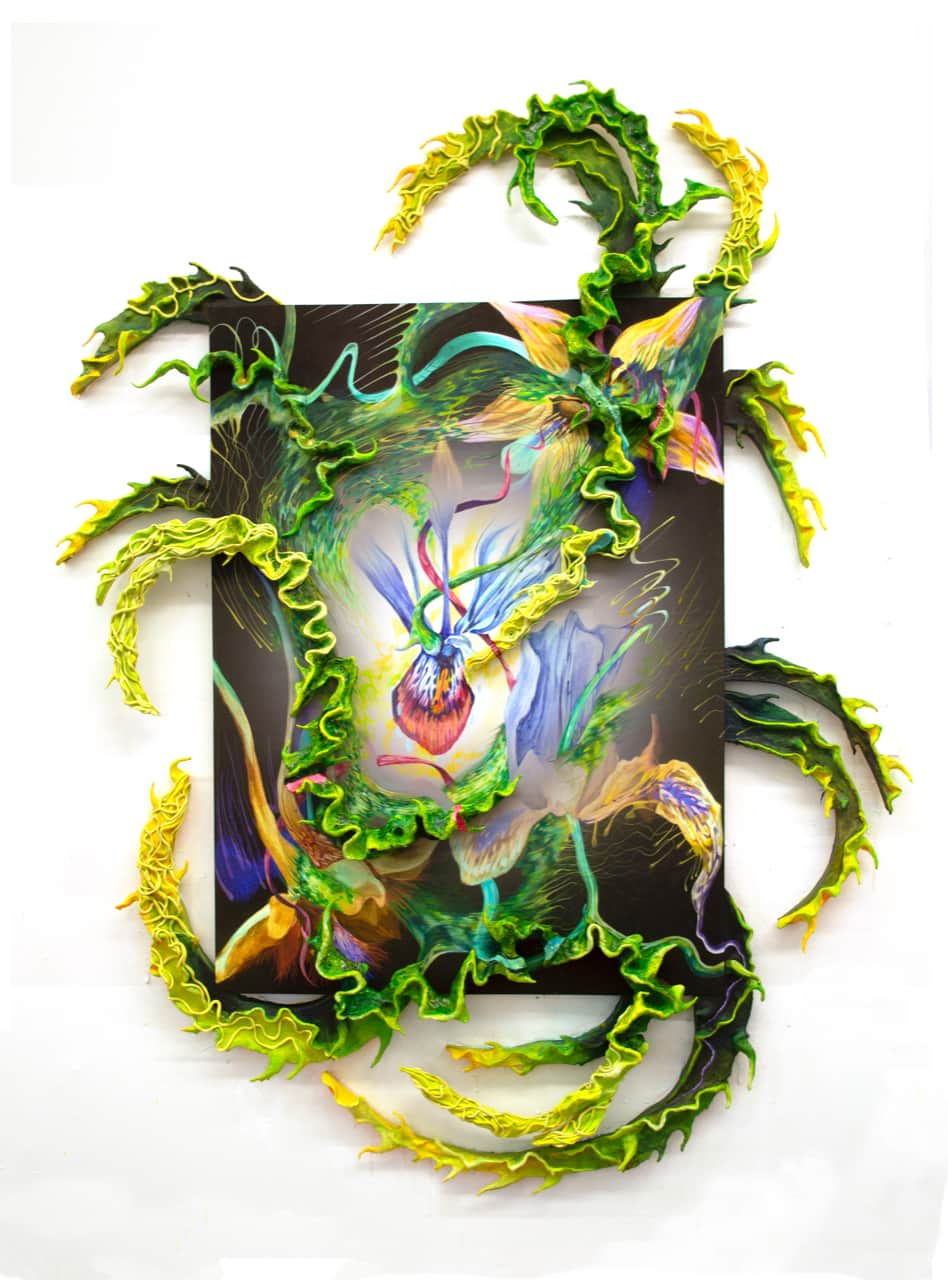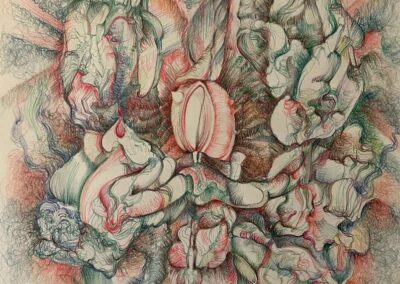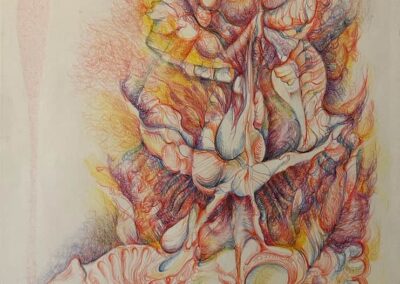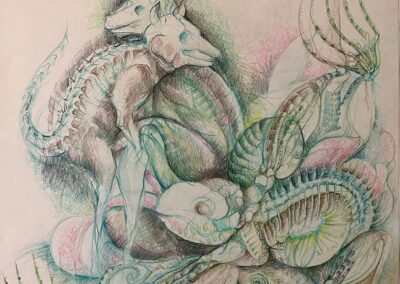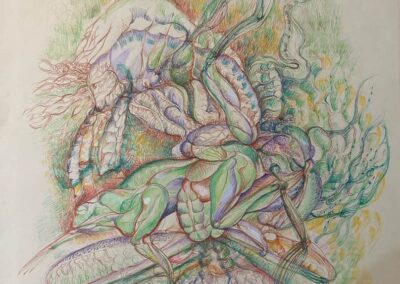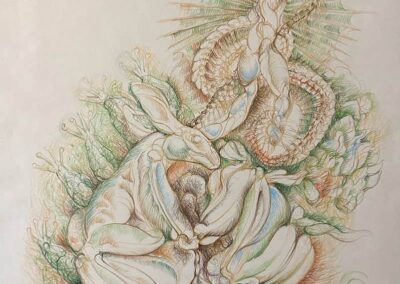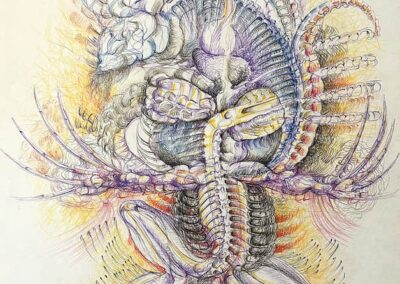Image:
Diana Sofía Lozano
Cyclone Studies, 2022
Heuristic Ecologies
Diana Sofia Lozano & Françoise Bagot
Exhibition opening March 7th, 2023
PROXYCO Gallery, 121 Orchard Street, New York, NY 10002
In anticipation of springtime, PROXYCO is proud to present Heuristic Ecologies, featuring the work of artists Diana Sofia Lozano (b.1992, Cali, Colombia) and Françoise Bagot (b.1940, Cabris, France). Heuristic Ecologies is curated by Paulina Ascencio Fuentes.
Drawing from methods of natural science representation –scientific illustration for Bagot and larger-than-life botanical models in the case of Lozano–each artist has developed wondrous ecosystems of their own. In Heuristic Ecologies, their work engages in an intergenerational conversation that renders visible the speculative potential of scientific depictions, envisioning biological specimens –erotic plants, mutant flowers, and intricate plant/animal hybridscohabitating (im)possible ecologies.
The organisms depicted in Heuristic Ecologies have found forms of resistance through hybridization. A concept widely explored in both postcolonial theory and horticulture, hybridization is the process of confrontation, exchange, and mutation that creates new forms of life and living. Occurring within contact zones –places of colonial encounters–the logic of resistance through cross-pollination implies adaptability and transformation not only to survive but to give life to stronger, thriving alliances.
Françoise Bagot arrived in Mexico in the 1960s to work as a scientific illustrator, developing an extensive catalog of archaeological, botanical, and zoological representations compiled in science books and stored in the cabinets of natural history museums. Broadening her prolific practice of technical drawing, Bagot created a series of works in the 1970s that entangle the natural realm with a spiritual, dreamy, –and even psychedelic– imagination. In this sense, Bagot’s creatures resist being subsumed by the taxonomic anxieties of Western science: they are not plants, animals, or minerals but speculative, surreal, disruptive living entities. A contemporary reading of these works allows us to envision the expectations of a future ecology centered on interspecies relationships –a world organized through friendships, affinities, and cooperation.
Diana Sofia Lozano has built an original inventory of large-scale compounded horticultural specimens through sculpture, installation, and drawing. The artist works with braided steel, colored resin clay, hand-dyed wool, and fabric to create other-worldly plants that leave traces of spores and mirrored spoors. The enlarged petals, roots, stems, pistils, thorns, and leaves are reminiscent of the detailed botanical models on display in natural science museums. Still, their deviant forms appeal further to lusus naturae than scientific accuracy. Inspired by nature’s mechanisms of adaptability and survival, Lozano’s flora has mutated into complex organisms that overcome extinction by becoming antic hybrids. In particular, the specimens installed in the first space of the gallery are inspired by Boliviana Negra (also known as “La Millonaria”), an enhanced, hard-to-destroy mutant species of coca resisting forms of chemical annihilation by U.S. military forces in South America. Lozano’s creatures camouflage by appealing to geospatial mapping patterns created by detection and surveillance technologies utilized by U.S. intervention projects. These patterns cover several surfaces of the works, functioning as a form of mimicry that would allow them to be indetectable to their predators.
The pairing of these artists is yet another form of encounter and exchange –one that arises from the clash of their practices and backgrounds. Bagot’s work bends and expands the constraints of scientific knowledge production, despite the colonial roots of her previously studied frameworks. Lozano, in contrast, works against these structures and explicitly problematizes their long geopolitical and social histories. Under these conditions of contention, a heuristic approach harvests a dialogue of resistance from a landscape of colonial extraction and regulation. In nature, nothing exists alone…
Paulina Ascencio Fuentes, March 2023
///
BIOS
Diana Sofia Lozano (b.1992, Cali, Colombia), is an artist based in Brooklyn, NY. Her work uses the language of botanical hybrids; the naturally occurring, genetically modified, and the imagined. Lozano presents biomimicry as metaphors for identity construction at the intersections of gender, sexuality, and the politics of difference.
She is interested in the deconstruction of botanical taxonomic failures in order to reveal and redefine the boundaries of colonial identificatory practices and geopolitical borders.
Lozano has exhibited at Company Gallery, Wave Hill Gardens, Deli Gallery, Rachel Uffner Gallery, and Proxyco Gallery in NYC, Guerrero Gallery in San Francisco, New Image Art in Los Angeles, Casa Prado in Barranquilla Colombia, Örebro Konsthall in Örebro Sweden, Parallel in Oaxaca Mexico, and Capsule Gallery in Shanghai China, among others.
Lozano is a 2021 MFA Graduate from Yale University.
Françoise Bagot (b.1940, Cabris, France) was born in the South of France, near the Côte d’Azur, where her parents had settled during the war. Her father studied architecture at the Beaux-Arts de París and musical composition at the Conservatoire. He offered her an early knowledge of drawing, and since childhood, Bagot decided to dedicate herself to visual arts.
Bagot returned to Paris in 1948, where she studied in several workshops and later at the École Nationale Aupérieure des Arts Décoratifs. In 1962 she worked at the Muséum national d’Histoire Naturelle as a scientific drawer of the flora of Madagascar. In 1966, Bagot was asked to join the French Archaeological and Ethnologic Mission in Mexico, where she married artist Zalathiel Vargas and installed her studio in 1970.
Her work has been shown in numerous exhibitions in galleries and museums in Mexico and France. Her practice is inspired by her experiences between these two countries, particularly by the richness of Mexican ancestral culture.
Paulina Ascencio Fuentes (b. 1988, Guadalajara, Mexico) is a researcher and curator, currently living in Lenapehoking (known today as New York), where she is pursuing a Ph.D. in Anthropology at New York University. She has a background in Philosophy and Social Sciences and holds a MA in Curatorial Studies from CCS, Bard College, New York. Between 2021-2022 she was a Hevey-Filling Fellow in the Department of Anthropology at the National Museum of Natural History, Smithsonian Institution, Washington, D.C.
Her research outlines transdisciplinary modes of knowledge production and transmission, analyzes cultural exchanges between Mexico and the United States, and approaches museums, archives, and collections as contact zones.

